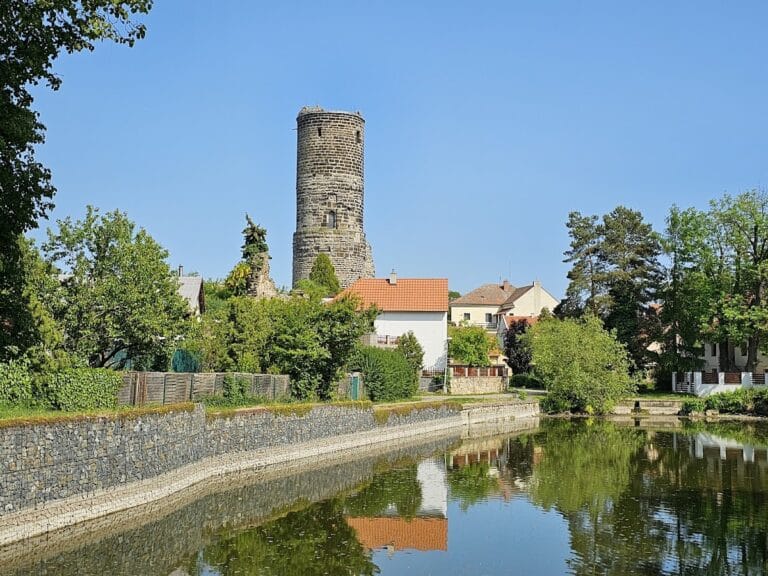King’s Court in Prague: A Medieval Royal Residence and Historical Site
Visitor Information
Google Rating: 4.6
Popularity: Medium
Google Maps: View on Google Maps
Official Website: www.hotelkingscourt.cz
Country: Czechia
Civilization: Unclassified
Remains: Military
History
The King’s Court (Králův dvůr) was a royal residence situated in Prague’s Old Town, in what is now the Czech Republic. This complex was constructed and developed by the Bohemian medieval monarchy, serving as a principal seat of the kingdom during the late 14th and 15th centuries.
Originally, the estate belonged to the Koldic lords and consisted of a palace along with adjacent houses for courtiers, extensive gardens, baths, and a lion house. Around 1383, King Wenceslaus IV moved from Prague Castle to this site, reportedly due to tensions with the queen dowager, and officially secured ownership after 1386. The King’s Court thereafter functioned as the primary royal residence for several rulers. These included Wenceslaus IV’s brother Sigismund of Luxembourg; Sigismund’s son-in-law Albert II of Habsburg; Ladislaus the Posthumous, who passed away within its walls; as well as George of Poděbrady, who also died here. Vladislaus II Jagellon lived at the court briefly until 1485 when, following the Second Defenestration of Prague, he returned to Prague Castle.
Although the King’s Court was the official royal seat from 1383 to 1485, the tradition of coronation processions starting at this location began only after Sigismund’s death. Four such documented processions took place during the 15th century, specifically in 1438, 1453, 1458, and 1471. Additionally, this site witnessed the departure of funeral processions for Ladislaus the Posthumous in 1457 and George of Poděbrady in 1471.
From the early 1400s to 1512, the Bohemian Land Tables (Zemské desky) were stored at the King’s Court. These were important legal records of the kingdom before they were relocated back to Prague Castle in 1515. Unfortunately, the Land Tables were destroyed in a fire in 1541.
Following the decline of its use as a royal residence after 1485, parts of the palace came under the possession of the Lobkowicz family through pawning. In 1631, Cardinal Ernst Adalbert of Harrach purchased the property and established a priestly seminary in 1636. Despite suffering a fire in 1689, the complex was rebuilt and enhanced with a Baroque Church of St. Adalbert, designed by architect Jean Baptiste Mathey and consecrated in 1705.
The seminary closed after the suppression of the Jesuit order in 1773, and later Josephine reforms resulted in the church’s closure. Between 1869 and 1900, the site housed a military cadet school. Ultimately, the original buildings were demolished in 1902–1903 to make way for the present Municipal House (Obecní dům). A commemorative bronze plaque on the Municipal House honors George of Poděbrady’s residence from 1454 to 1471, emphasizing the site’s historical role as a center of political and religious life.
Remains
Archaeological investigations have revealed that the King’s Court extended over an area arranged in a triangular layout, marked by a tower palace located in the southwest wing. This complex comprised a large hall that served for royal assemblies and official functions, complemented by gardens and dwellings for servants and courtiers. The palace was strategically positioned near the Nicholas Gate, historically known as the Mountain Gate and today called the Powder Gate, which lay on the road connecting Prague to Kutná Hora.
Within the court’s grounds, there were specialized buildings including baths for hygiene and a lion house (lvinec), which likely served to keep lions or other exotic animals symbolizing royal power. Adjacent to the complex, across today’s Celetná Street, stood the Queen’s Court (Dvůr králové). This neighboring property had former owners such as the Velfl family and was used by King Wenceslaus IV and later Queen Johanna, spouse of George of Poděbrady.
Excavations have uncovered foundational walls of the original palace, providing insight into its construction and spatial organization. These remains are preserved underground, with no standing above-ground structures surviving. While the Baroque Church of St. Adalbert, added in the 17th century to serve the seminary complex, was once a prominent feature designed by Jean Baptiste Mathey and consecrated in 1705, it no longer exists on the site today.
In contemporary terms, the location’s heritage is commemorated through the archaeological remnants and the street name Králodvorská, which recalls the medieval court. This street was formerly called Benediktská, a name derived from the nearby Church of St. Benedict, demolished in 1792. Visual historical sources, including an illustration from the mid-18th century, depict the King’s Court together with the Church of St. Adalbert, offering a glimpse into the site’s layered past.










